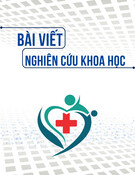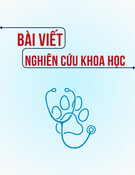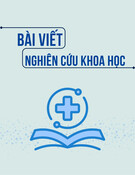
N. Tien Thong, N. Tuan Viet, H. Hai Anh / Tạp chí Khoa học và Công nghệ Đại học Duy Tân 04(65) (2024) 255-263
255
Analysis of pharmacy inspection results for retail drugstores
in Central region of Vietnam from 2018 to 2022
Phân tích kết quả thanh tra dược đối với cơ sở bán lẻ thuốc khu vực miền Trung Việt Nam
giai đoạn 2018 - 2022
Nguyen Tien Thonga, Nguyen Tuan Vietb,c, Ha Hai Anhc,d*
Nguyễn Tiến Thônga, Nguyễn Tuấn Việtb,c, Hà Hải Anhc,d*
aK23MPM, College of Medicine and Pharmacy, Duy Tan University, Da Nang, 550000, Vietnam
aLớp cao học K23MPM, Trường Y Dược, Trường Ðại học Duy Tân, Ðà Nẵng, Việt Nam
bDa Nang Department of Health, Da Nang, 550000, Vietnam
bSở Y tế Đà Nẵng, Đà Nẵng, Việt Nam
cDa Nang Pharmaceutical Association, Da Nang, 550000, Vietnam
cHội Dược học Đà Nẵng, Đà Nẵng, Việt Nam
dFaculty of Pharmacy, College of Medicine and Pharmacy, Duy Tan University, Da Nang, 550000, Vietnam
dKhoa Dược, Trường Y Dược, Trường Ðại học Duy Tân, Ðà Nẵng, Việt Nam
(Date of receiving article: 06/03/2024, date of completion of review: 02/04/2024, date of acceptance for posting:
11/06/2024)
Abstract
Introduction: Ensuring compliance with standards and regulations in the retail pharmaceutical sector is essential for
protecting public health through maintaining the quality and safety of medications until their use. This study investigates
the publication of inspection results of retail drugstores and the state of regulatory compliance at these facilities in the
Central region of Vietnam, focusing on the city of Da Nang and several surrounding provinces. Methods: Using a
retrospective descriptive method by employing a dual approach of website analysis and keyword searches, the study
collected data from official portals and government websites. Selection criteria included reports on pharmaceutical
inspection results at pharmacies from 2018 to 2022. Data was gathered and analyzed to assess inspection outcomes,
identify common violations, and compare regulatory practices across different jurisdictions. Results and discussion: The
inspection results analysis of 558 pharmacies revealed 90 violations (16.1%), with main issues including incorrect record-
keeping and improper storage processes. Despite a general trend towards transparency and clarity in professional
management at retail units, the data indicate that there are still prominent issues that require attention. The findings of
this study align with previous global research, indicating common challenges in ensuring regulatory compliance at
pharmacies. These findings emphasize the importance and challenges of pharmacies continuing to improve professional
quality and compliance, focusing on common violations for prioritization in remediation and prevention.
Conclusion: To enhance the safety and ensure the quality of pharmaceutical products reaching consumers, this study
proposes insights and the importance of ongoing monitoring, stricter regulatory enforcement, and innovations in the
quality management of pharmacy operations to accommodate evolving trends in the pharmaceutical industry within the
context of scientific and technological advancements.
Keywords: Pharmaceutical inspection; regulatory compliance; good pharmacy practice; central region of Vietnam; public
health safety.
*Corresponding author: Ha Hai Anh
Email: hahaianh@dtu.edu.vn
04(65) (2024) 255-263
DTU Journal of Science and Technology
D U Y T A N U N I V E R S I T Y
TẠP CHÍ KHOA HỌC VÀ CÔNG NGHÊ ĐẠI HỌC DUY TÂN

N. Tien Thong, N. Tuan Viet, H. Hai Anh / Tạp chí Khoa học và Công nghệ Đại học Duy Tân 04(65) (2024) 255-263
256
Tóm tắt
Giới thiệu: Việc đảm bảo tuân thủ các tiêu chuẩn và quy định trong lĩnh vực bán lẻ dược phẩm là cần thiết để bảo vệ sức
khỏe cộng đồng thông qua duy trì chất lượng và tính an toàn của thuốc cho đến khi được sử dụng. Nghiên cứu này khảo
sát việc công bố kết quả thanh tra cơ sở bán lẻ thuốc và tình hình tuân thủ quy định chuyên môn tại các cơ sở này ở khu
vực miền Trung Việt Nam, tập trung vào thành phố Đà Nẵng và một số tỉnh lân cận.
Phương pháp: Sử dụng phương pháp hồi cứu mô tả, với cách tiếp cận kép gồm phân tích trang web và tìm kiếm theo từ
khóa, nghiên cứu thu thập dữ liệu từ các cổng thông tin chính thức và trang web của Chính phủ. Tiêu chí lựa chọn bao
gồm các báo cáo kết quả thanh tra dược tại nhà thuốc từ năm 2018 đến 2022. Dữ liệu được thu thập và phân tích các kết
quả kiểm tra, xác định các vi phạm phổ biến và so sánh thực tiễn quy định giữa các khu vực pháp lý khác nhau. Kết quả
và thảo luận: Phân tích kết quả thanh tra trên 558 nhà thuốc cho thấy có 90 nhà thuốc vi phạm (16,1%). Các lỗi vi phạm
chủ yếu bao gồm ghi chép số liệu không đúng cách và quy trình lưu trữ không đảm bảo kỹ thuật. Mặc dù có xu hướng
chung hướng tới sự minh bạch, rõ ràng trong quản lý chuyên môn tại đơn vị bán lẻ, dữ liệu chỉ ra rằng vẫn còn những vấn
đề nổi cộm cần lưu ý. Kết quả của nghiên cứu phù hợp với các nghiên cứu trước đây trên thế giới, cùng chỉ ra các trở ngại
phổ biến trong việc đảm bảo tuân thủ quy định tại nhà thuốc. Các phát hiện này nêu ra tầm quan trọng và những thách
thức trong việc các nhà thuốc cần tiếp tục nâng cao chất lượng chuyên môn và tuân thủ quy định, chú ý các vi phạm phổ
biến để ưu tiên khắc phục và phòng ngừa.
Kết luận: Để nâng cao an toàn và đảm bảo chất lượng sản phẩm thuốc đến tay người dùng, nghiên cứu này đề xuất góc
nhìn và tầm quan trọng của việc giám sát liên tục, thực thi quy định nghiêm ngặt hơn nữa, đồng thời cần có những cải
tiến trong hệ thống pháp quy nhằm tạo điều kiện thích ứng với các xu hướng ngành dược đang phát triển trong bối cảnh
tiến bộ của khoa học công nghệ.
Từ khóa: Thanh tra dược; pháp chế dược; thực hành nhà thuốc tốt; nhà thuốc miền Trung Việt Nam; an toàn sức khỏe
cộng đồng.
1. Introduction
The pharmaceutical retail sector plays a
critical role in ensuring public access to safe and
effective medications, making the lawful
operation of drugstores imperative [1].
Oversight of drugstore operations through
pharmaceutical inspections, conducted by
regulatory authorities, is essential for upholding
regulatory compliance and maintaining
standards [14,17]. Through periodic inspections
and assessments, pharmaceutical inspections
ascertain that standards and regulations related
to the sale of medicines at drugstores are strictly
adhered to, concurrently ensuring the safety and
quality of pharmaceutical products accessible to
consumers. Developed countries, such as the
United States and European Union countries,
exhibit stringent compliance to good pharmacy
practices (GPP), markedly reducing incidents of
expired medication sales and dispensing errors,
largely attributed to robust regulatory
frameworks and periodic inspections [8].
Conversely, developing regions, including
Vietnam, face challenges such as inadequate
storage and record-keeping [4,12].
In Vietnam, the management and adherence
to regulations regarding the operation of
drugstores have received considerable attention
and high evaluation from governmental agencies
and healthcare organizations. Nevertheless,
despite the concentrated efforts from the
government and the pharmaceutical sector,
challenges persist concerning the enforcement
of regulations and standards governing
drugstore operations [3].
According to the stipulations of the 2022
Inspection law [18], which replaced the previous
2010 law [17], and the corresponding guiding
decrees [14-15], the disclosure of
pharmaceutical inspection results on official
portals has become mandatory. However, with
the new law taking effect from July 2023,
specific deadlines for publishing inspection
results have been outlined.
This study aims to provide an overview of the
current state of affairs regarding the
publicization of pharmaceutical inspection
results by local government agencies
responsible for overseeing retail pharmaceutical

N. Tien Thong, N. Tuan Viet, H. Hai Anh / Tạp chí Khoa học và Công nghệ Đại học Duy Tân 04(65) (2024) 255-263
257
establishments within their jurisdictions.
Specifically, the research focuses on examining
the practices of Da Nang and several provinces
in the Central region. By scrutinizing inspection
outcomes and identifying prevalent issues and
challenges at the local level, this research seeks
to offer insights that can inform concrete
solutions to enhance the management
effectiveness of good pharmacy practices (GPP)
[16]. Ultimately, the goal is to ensure the safety
and quality of pharmaceutical products
consumed by the public amidst evolving
regulatory landscapes and industry trends.
2. Materials and methods
2.1. Sampling method and data collection
Using a retrospective descriptive method by
employing a dual approach, this research
employs a combination of two methods to gather
information on pharmaceutical inspection
results. Firstly, the study involves browsing the
portal websites of selected provincial health
departments to identify relevant sections
containing information on pharmaceutical
inspection activities and official notifications of
inspection results. Secondly, the research
utilizes the Google search engine, employing
keywords such as "thanh tra" (inspection),
"thanh tra dược" (pharmaceutical inspection),
"kết quả thanh tra" (inspection results), "nhà
thuốc" (pharmacy), "cơ sở bán lẻ" (retail
facility), and "hiệu thuốc" (drugstore), along
with search limitations using the "site:" operator
for domain restriction to government websites
(e.g., domain_name.gov.vn).
2.2. Selection criteria
Reports containing inspection-related
information are included if they meet specific
criteria, including being in common electronic
file formats, written using official document
formats, and containing digital signatures or
clear indications of the signatory's name, date of
issuance, and document number. Exclusion
criteria encompass webpage articles or other
types of content lacking attached files, as well as
documents hosted outside the domain of the
provincial health department portal.
2.3. Data processing and analysis
Information extracted from the reports meeting
the screening criteria includes the date of
inspection, the number of drugstores inspected,
the number of violations identified, the types of
violations, and the actions taken to address
violations.
To ensure objectivity and reliability, the
research verify data consistency and reliability
by cross-checking and comparing data collected
from various sources. Key study variables
include the number of days from the inspection
date to the publication of inspection results
(based on the date of issuance), the number of
pharmaceutical retail facilities found in violation
categorized by the type of violation, and the total
number of recorded violations during
pharmaceutical inspections at each facility.
Statistical analyses were conducted as follow:
ANOVA test was conducted to statistically
examine the differences in publishing times
among these regions. The differences in the rates
of pharmacy violations across various localities
were statistically examined using Epi Info 7,
conducting Chi-square test with significance set
at p<0.05. When the expected frequencies in any
of the categories were below 5, Fisher-exact test
was employed to ensure the validity of the
significance testing. Odds Ratios (ORs)
quantified the strength of these associations,
considered significant if their 95% confidence
intervals did not include 1.
Data visualization: Findings were presented
through charts and tables, with data visualization
conducted using Microsoft Excel.

N. Tien Thong, N. Tuan Viet, H. Hai Anh / Tạp chí Khoa học và Công nghệ Đại học Duy Tân 04(65) (2024) 255-263
258
3. Results
3.1. Overview of pharmaceutical inspection
result publication
The examination of pharmaceutical
inspection result publication revealed a
consistent trend over the years from 2018 to
2022. Figure 1 illustrates the number of reports
published each year, indicating fluctuations but
an overall stable pattern. The highest number of
reports was observed in 2022, with 06 reports
published, while the lowest was in 2020, with
only 1 report. These figures provide insights into
the frequency of publicized inspection outcomes
within the selected localities.
Figure 1. Number of pharmacy inspection reports published each year in surveyed city/provinces
3.2. Inspection results publishing time
Data in Table 1 presents a comparative
analysis of the average times required to publish
pharmacy inspection results across five distinct
provinces/cities. The analysis spans several
years, capturing variability in administrative
efficiency. Binh Dinh, Da Nang, Gia Lai, Ha
Tinh, and Quang Ngai are included, with their
respective average publishing times detailed. A
noteworthy finding is the range of average times,
from as low as 3.0 days in Gia Lai to as high as
18.5 days in Ha Tinh. The overall average across
all provinces/cities, calculated at approximately
11.3 days.
Table 1. Average pharmacy inspection result publishing times across localities
Province/City
Average publishing
time (days)
Binh Dinh
10.0
Da Nang
5.8
Gia Lai
3.0
Ha Tinh
18.5
Quang Ngai
8.0
Total average
11.3
0
1
2
3
4
5
6
7
2018 2019 2020 2021 2022
Number of reports
Year of publication
Number of official reports of inspection published by provines/city
Ha Tinh Da Nang Quang Ngai Gia Lai Binh Dinh

N. Tien Thong, N. Tuan Viet, H. Hai Anh / Tạp chí Khoa học và Công nghệ Đại học Duy Tân 04(65) (2024) 255-263
259
Additionally, an ANOVA test was conducted
to statistically examine the differences in
publishing times among these regions, yielding
an F-statistic of approximately 1.19 and a p-
value of 0.36 (> 0.05), indicating no statistically
significant differences in publishing times
among the regions.
3.3. Analysis of pharmaceutical inspection
result publication
Out of 558 drugstores inspected within the
scope of this study, 90 were found to be in
violation of regulations, indicating a substantial
compliance gap. Table 2 presents a detailed
analysis of the pharmaceutical inspection
results, showcasing vital variables and
corresponding values. The types of violations
varied, with the most common being lack of
proper documentation (15.8%), and storage
violations (10.6%). On average, each facility
recorded approximately 2.9 violations,
emphasizing the prevalence of multiple
infractions within individual drugstores. The
predominant enforcement actions taken included
issuing warning notices with suspension of
drugstore operations (5.6%) and imposing fines
(9%), highlighting the regulatory response to
non-compliance by the local authorities. The
analysis result suggests the need for stringent
enforcement measures to ensure adherence to
pharmaceutical regulations and standards.
Table 2. Summary of pharmaceutical inspection result publication
Variable
Value
Number of drugstores inspected
558
Number of drugstores found in violation
90
Average number of violations per facility
2.9
Common types of violations
- Lack of proper documentation (15.8%)
- Storage violations (10.6%)
Enforcement actions taken
- Warning notices issued, suspension of
drugstore operations (5.6%)
- Fines imposed (94.4%)
3.4. Comparison of inspection results across
localities
Result in Table 3 provides a comparative
analysis of inspection results between Da Nang
and other provinces in the Central region. In
examining inspection results across five
localities, significant variability was observed.
The χ2 Test demonstrated that Da Nang, Quang
Ngai, and Gia Lai had statistically notable
differences in violation frequencies compared to
others. The prevalence of pharmacy violations in
Da Nang (20.7%) and Gia Lai (32.4%) is
respectively 1.75 times (OR=1.75 [1.04-2.93])
and 3.52 times (OR=3.52 [2.03-6.10]) higher
compared to other localities in the region.
Notably,Quang Ngai has the lowest rate of
pharmacy violations (4.3%), which is only 0.24
times (OR=0.24 [0.07-0.63]) that of the other
regions. These disparities suggest differential
regulatory compliance and enforcement
efficacy. Particularly, Gia Lai's markedly higher
Odds Ratio warrants further investigation into
local practices.











![Tài liệu Triệu chứng học nội khoa [mới nhất]](https://cdn.tailieu.vn/images/document/thumbnail/2025/20251204/oanhlahet@gmail.com/135x160/5231764900514.jpg)


![Bài giảng Vi sinh vật: Đại cương về miễn dịch và ứng dụng [chuẩn nhất]](https://cdn.tailieu.vn/images/document/thumbnail/2025/20251124/royalnguyen223@gmail.com/135x160/49791764038504.jpg)











